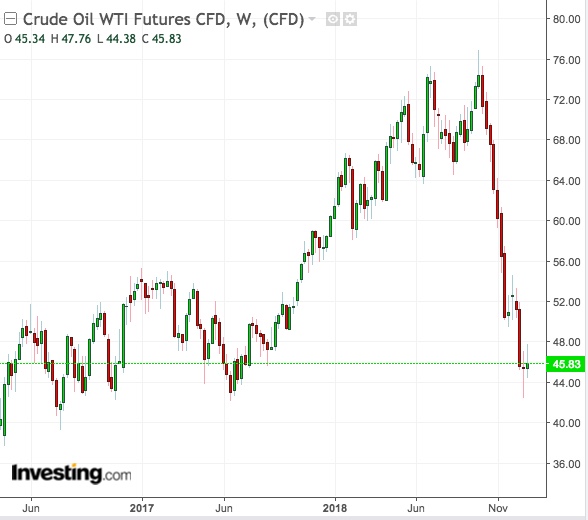The first trading day of the New Year has come and gone, and oil traders haven’t found it assuring at all.
After Wednesday’s soft open in Asia, followed by further weakness in Europe and a sudden rally to the close in New York, more unsettled trends seem to be in the offing with another faltering start in Asian trading on Thursday.
None of these would be extraordinary in any regular trading day for oil. Like any commodity, crude is expected to see price divergence when faced with shifting supply-demand factors.
No Ordinary Times For Oil
Yet, these aren’t ordinary times for oil. This is supposed to be the year when OPEC, in partnership with Russia, seizes the market back from the bears by proving its commitment to slash supply to the tune of 1.2 million barrels per day over the next six months—or however much is necessary to recoup last year’s 40 percent price plunge.

Oil bulls are counting on the Organization of the Petroleum Exporting Countries to stay on message with their production cuts, as any fumble on OPEC’s part will complicate the delicate task of restoring positive sentiment to the market. It took less than 11 weeks for the bears to destroy the 18 months of work done by the cartel on its previous round of cuts.
And the group of oil-producing countries seemed to get the balance just right on the first trading day of the year, as, a few hours after the start of New York’s session on Wednesday, Bloomberg reported that tanker-tracking data it compiled showed crude exports from Saudi Arabia fell a half-million barrels to 7.253 million bpd in December, thanks to deliberate squeezes applied by the Kingdom on shipments to the United States and China.
That sent US West Texas Intermediate crude and UK Brent, the global benchmark for oil, as high as 4 percent in New York’s intraday trading.
Global Macro Risks
But WTI could only settle up 2.5 percent. And the reason for the close off the highs was as valid as OPEC’s much-hyped cuts: a worrying decline in global factory data.
In an uncoordinated rollout that somehow came together, China’s Purchasing Manager Index (PMI) contracted for the first time in 19 months in December while comparative US and Europe data were also dismal.
China’s PMI number of 49.7 indicated weaker-than-expected factory activity in the world's second largest economy, which many economists believe is headed for a slowdown this year. While the EU as a whole imports around 14 million bpd of crude a year, the single largest consuming nation for oil is China, with 8.4 million bpd. A contracting Chinese economy will, therefore, have major ramifications for oil demand.
Dominick Chirichella, director of risk and trading at the Energy Manufacturing Institute in New York said:
“Manufacturing is an energy intensive sector and any contraction could result in China’s energy demand also slowing.”
In other factory data on Wednesday, US PMI reading for December was revised down to 53.8, marking an outright lowest reading since September 2017. Meanwhile, in Europe, Euro zone manufacturing activity barely expanded at the end of 2018 in a broad-based slowdown.
Such negative macro risks, which accelerated oil’s slide in the last few weeks of December, could feature prominently this year too if there’s a buildup toward a global recession, warn economists. And that might turn out to be OPEC’s biggest headache.
Forecasting 2019 'More Hazardous Than Usual'
Neil Atkinson, head of oil markets at the International Energy Agency, was quoted by Bloomberg saying that forecasting trends in 2019 was “even more hazardous than usual”.
John Kilduff, founding partner at New York energy hedge fund Again Capital, told Investing.com:
"We're going to see lots of volatility as (OPEC’s) production cuts face off with whatever weak demand projected for oil, amid the global slowdown everyone's talking about."
In Thursday’s trading, global markets were roiled by a more than 3 percent slump of the US dollar against the Japanese yen overnight, and after tech giant Apple (NASDAQ:AAPL) cut its sales forecast. A weaker dollar should be good for oil and other commodities as they make such raw materials priced in the greenback more appealing to holders of other currencies. Yet oil ignored the weaker USD, slumping along with other financial markets.
Reuters quoted investment bank Jefferies as saying in a 2019 opening note to clients and employees that the start of the year
"doesn't feel as firm, the future doesn't feel as certain and optimistic, and the path forward does not seem as clear."
Shipping brokerage Eastport, meanwhile, said the turmoil in markets was scaring off investors:
"Falling share prices tend to damage consumer sentiment, which often results in increased caution and reduced spending...Business managers also tend to limit capex, thus weighing on investment as well."
US Shale Remains The Market’s Dark Horse
The Saudis could also cut February prices for heavier crude grades sold to Asia due to weaker fuel oil margins, a Reuters survey said separately on Thursday. Such a development, if true, would further weigh on the overall oil price.
All said, the dark horse for the oil market remains US crude production, which reached a record high and world-topping 11.7 million bpd in 2018. Output of shale oil, the main component of US oil production, is expected to grow further in 2019 to push total volumes to 12 million bpd.
The US produces the light, “sweet” crude that might be perfect for gasoline, and not the heavier “sour” oil from the Middle East that American refineries need for turning out diesel and other middle distillates. But in a market focused on total production numbers, it is US crude that is determining price direction.
Ryan Lance, CEO of ConoccoPhillips, said:
“We expect oil markets to remain volatile, in part driven by flexible North American shale production that can ramp up and down quickly in response to changes in investment levels.”
